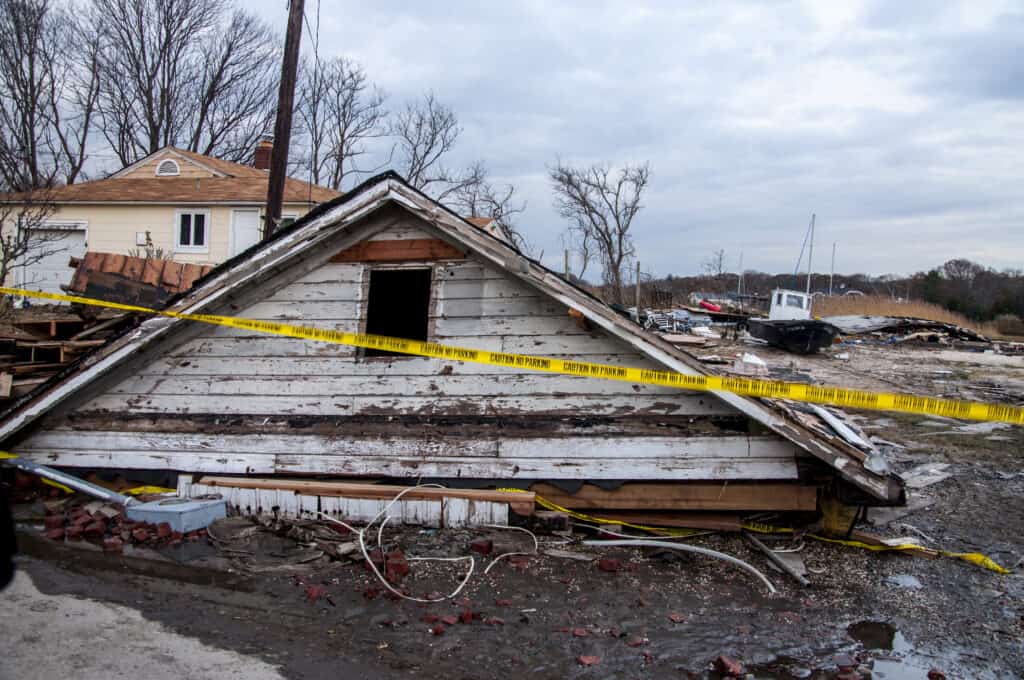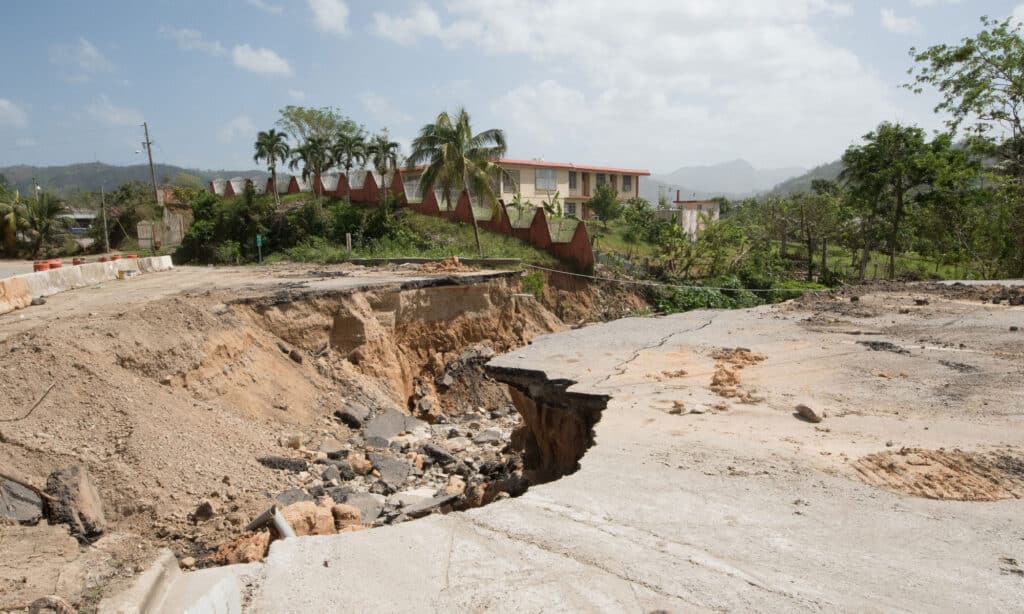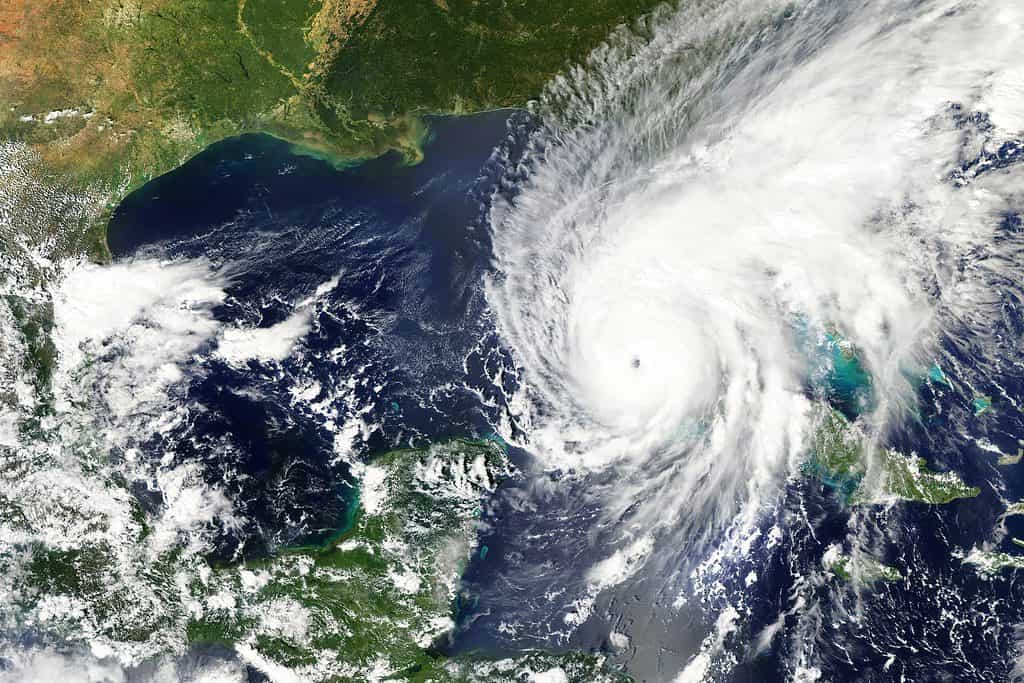The hurricanes listed in this post are among the biggest hurricanes of the most recent decade (2010) in the United States. Many are listed based on their intensity and damage in dollars. Some were chosen based on the number of casualties alone. While not all are of the highest intensity possible, each hurricane listed is devastating in its own right. All hurricanes on this list are a minimum category 3. Although there were many major storm systems between 2010 and 2020, we have narrowed it down to the top 5 “biggest” hurricanes during this time. They are ranked in chronological order.
1. 2012 – Hurricane Sandy

Hurricane Sandy became the largest Atlantic hurricane on record, with a top speed of up to 115mph.
©Cathy Kovarik/Shutterstock.com
Category 3
Hurricane Sandy, also known as “Superstorm Sandy,” was an extraordinarily powerful and devastating hurricane. It had winds of a tropical storm’s strength that could be felt 1,150 miles away. It was also the largest Atlantic hurricane ever recorded in terms of circumference. This hurricane killed 233 people in eight nations, from the Caribbean to Canada. It caused damage of around $70 billion (2012 USD).
Hurricane Sandy hit 24 states in the US, encompassing the whole eastern shore. Florida, Maine, the Appalachians, Michigan, and Wisconsin, were impacted, with New York and New Jersey suffering the most damage. On October 29, its storm surge struck New York City, flooding streets, tunnels, and subway lines. It also knocked out power throughout the area. The United States sustained damage of $65 billion (2012 USD).
2. 2017 – Hurricane Maria

A mudslide caused by Hurricane Maria in San Juan Peurto Rico – an unincorporated territory of the United
States.
©iStock.com/cestes001
Category 5
The 2017 storm season had extensive and disastrous effects. Critical infrastructure damage slowed down response efforts. This also led to cascading failures of energy, transportation, communications, water supply, and wastewater treatment systems. On September 20, 2017, Hurricane Maria, a category 5 hurricane, hit Puerto Rico. The U.S. Virgin Islands, a federally recognized, unorganized territory of the U.S., have never experienced a worse natural calamity.
Hurricane Maria was the second category 5 wind to be recorded in 2017’s active hurricane season. The wind’s greatest speed was 175 mph. In Puerto Rico, Dominica, and the Dominican Republic, the hurricane left behind substantial devastation. Puerto Rico, where more than 2900 deaths were reported, was the most severely affected of all these. The storm is the third-costliest tropical cyclone on record. Total damages are projected to be upwards of $91.61 billion (2017 USD), with most of those losses occurring in Puerto Rico.
3. 2017 – Hurricane Harvey

Flooding in Spring, Texas, a couple of miles north of Houston, during Hurricane Harvey in 2017.
©MDay Photography/Shutterstock.com
Category 4
With gusts of 130 mph, Category 4 Hurricane Harvey initially touched down on San Jose Island in Texas in 2017. A few hours later, Harvey made landfall in Texas. Three hundred thousand buildings and 500,000 automobiles are thought to have been destroyed or damaged in the state.
The hurricane turned into a tropical storm and stalled over Texas. It dumped almost 30 inches of rain in the metropolitan area of Houston over the course of three days. After hitting Louisiana, Harvey returned to the Gulf of Mexico. It then moved northeastward as a tropical depression, triggering additional flooding along the way. It is estimated that the total cost of the flooding, building damage, car damage, property loss, and other related disasters was $125 billion. There were over 100 reported deaths that were caused directly by the storm.
4. 2018 – Hurricane Ian

Hurricane Ian heading toward the coast of Florida in September 2022
©lavizzara/Shutterstock.com
Category 4
Hurricane Ian made landfall on September 28, 2022, close to Cayo Costa in southwestern Florida after tearing through the Caribbean. The Category 4 storm was barely 7 mph away from being classified as a Category 5 storm with a wind speed of 150 mph. Along with strong gusts and heavy rain, a large storm surge triggered flooding on Florida’s west coast that reached heights of 12 to 18 feet above the ground.
The primary concern following Ian’s downgrading to a tropical storm on September 29 was the torrential rain, including almost 17 inches of rainfall in a day in Lake Wales, Central Florida. After making it across the state, Hurricane Ian grew stronger in the Atlantic Ocean. In Georgetown, South Carolina, it made landfall on September 30 as a Category 1 storm, bringing with it severe storm surge flooding.
In total, 148 people died as a result of Hurricane Ian, with 119 of the deaths being attributable to the storm’s flooding, wind gusts, and other hazardous circumstances. Even though the complete impact of Hurricane Ian is unknown, estimates suggest that the damage could total as much as $70 billion.
5. 2020 – Hurricane Laura

A selective focus shot of a dock in Grand Cayman as Hurricane Laura passes by.
©Drew McArthur/Shutterstock.com
Category 4
For those who were in Hurricane Laura’s path, the realism of grappling with a hurricane in the middle of a global epidemic hit home. On August 27, 2020, this category 4 hurricane struck the southwest coast of Louisiana. The hurricane struck the southwest of the state of Louisiana with winds of 150 mph, making it the most powerful hurricane to do so since records have been kept. It made landfall close to Cameron, Louisiana.
The powerful winds of Hurricane Laura damaged or entirely toppled homes, other structures, trees, power lines, and electricity poles. Large-scale flooding occurred in Louisiana and Arkansas as a result of a storm surge that rose 12 to 18 feet above the ground. Hurricane Laura caused at least $19 billion in overall losses and killed 77 people.
The photo featured at the top of this post is © iStock.com/Eric Overton
Sources
- MSN, Available here: https://www.msn.com/en-us/weather/topstories/these-are-the-strongest-hurricanes-ever-to-hit-the-united-states/ss-AA14u2mU#image=11
- U.S. News, Available here: https://www.usnews.com/news/best-states/slideshows/the-deadliest-storms-in-us-history
Thank you for reading! Have some feedback for us? Contact the AZ Animals editorial team.






